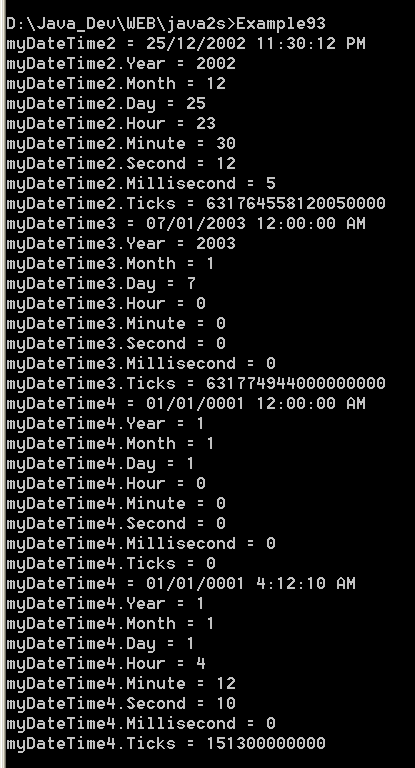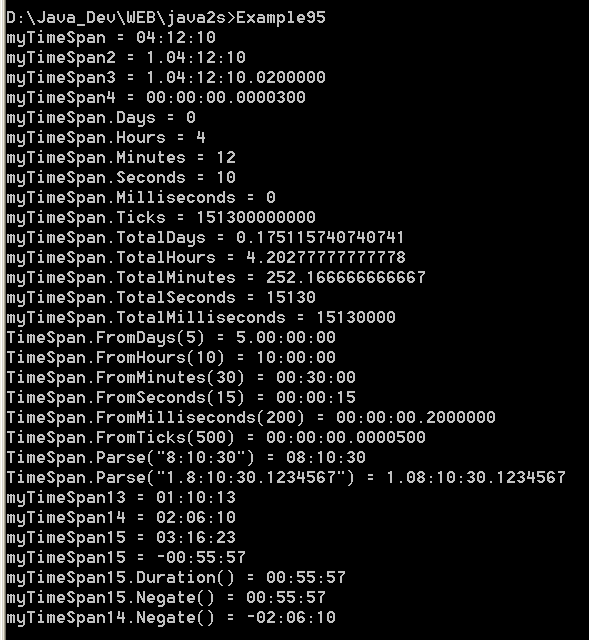Illustrates the use of DateTime and TimeSpan instances

/*
Mastering Visual C# .NET
by Jason Price, Mike Gunderloy
Publisher: Sybex;
ISBN: 0782129110
*/
/*
Example9_3.cs illustrates the use of DateTime and TimeSpan instances
*/
using System;
public class Example9_3
{
public static void DisplayDateTime(
string name, DateTime myDateTime
)
{
Console.WriteLine(name + " = " + myDateTime);
// display the DateTime's properties
Console.WriteLine(name + ".Year = " + myDateTime.Year);
Console.WriteLine(name + ".Month = " + myDateTime.Month);
Console.WriteLine(name + ".Day = " + myDateTime.Day);
Console.WriteLine(name + ".Hour = " + myDateTime.Hour);
Console.WriteLine(name + ".Minute = " + myDateTime.Minute);
Console.WriteLine(name + ".Second = " + myDateTime.Second);
Console.WriteLine(name + ".Millisecond = " +
myDateTime.Millisecond);
Console.WriteLine(name + ".Ticks = " +
myDateTime.Ticks);
}
public static void Main()
{
// create a DateTime instance, specifying the year,
// month, and day
int year = 2002;
int month = 12;
int day = 25;
DateTime myDateTime = new DateTime(year, month, day);
// create a DateTime instance, specifying the year,
// month, day, hour, minute, second, and millisecond
int hour = 23;
int minute = 30;
int second = 12;
int millisecond = 5;
DateTime myDateTime2 =
new DateTime(year, month, day, hour, minute, second, millisecond);
// create a DateTime instance, specifying the year,
// month, day, and JulianCalendar object
System.Globalization.JulianCalendar myCalendar =
new System.Globalization.JulianCalendar();
DateTime myDateTime3 =
new DateTime(year, month, day, myCalendar);
// create a DateTime instance, specifying the number of ticks
DateTime myDateTime4 = new DateTime(0);
// display the various DateTime instances
DisplayDateTime("myDateTime", myDateTime);
DisplayDateTime("myDateTime2", myDateTime2);
DisplayDateTime("myDateTime3", myDateTime3);
DisplayDateTime("myDateTime4", myDateTime4);
// create a TimeSpan instance, and add it to myDateTime4
TimeSpan myTimeSpan = new TimeSpan(4, 12, 10);
myDateTime4 += myTimeSpan;
DisplayDateTime("myDateTime4", myDateTime4);
}
}
Related examples in the same category
| 1. | Current date and time | | |
| 2. | What day of the month is this? | | |
| 3. | Do some leap year checks | | |
| 4. | Look at the min and max date/time values | | |
| 5. | Output DateTime object | | |
| 6. | Constructors of DateTime | | |
| 7. | comparisons between DateTime objects | | |
| 8. | Parse and ParseExact | | |
| 9. | DateTime Now and its calculation | | |
| 10. | new DateTime(1900, 2, 29) | | |
| 11. | new DateTime(1900, 2, 29, new JulianCalendar()) | | |
| 12. | Specify Kind DateTime | | |
| 13. | Offset of DateTime | | |
| 14. | DateTime and TimeSpan Instances | | |
| 15. | use the Now and UtcNow properties to get the currrent date and time | | |
| 16. | display the Date, Day, DayOfWeek, DayOfYear,Ticks, and TimeOfDayProperties of myDateTime | | |
| 17. | use the Compare() method to compare DateTime instances | | |
| 18. | use the overloaded less than operator (<) to compare two DateTime instances | | |
| 19. | use the Equals() method to compare DateTime instances | | |
| 20. | use the DaysInMonth() method to retrieve the number of days in a particular month and year | | |
| 21. | use the IsLeapYear() method to determine if a particular year is a leap year | | |
| 22. | use the Parse() method to convert strings to DateTime instances | | |
| 23. | use the Subtract() method to subtract a TimeSpan from a DateTime | | |
| 24. | use the overloaded subtraction operator (-) to subtract a TimeSpan from a DateTime | | |
| 25. | Displays the words 'Hello World!' on the screen, along with the current date and time | |  |
| 26. | illustrates the use of TimeSpan properties and methods | |  |
| 27. | A simple clock | |  |
| 28. | Estimates pi by throwing points into a square. Use to
compare execution times | |  |
| 29. | Change current culture and back | | |
| 30. | How values you passed into contructor mapped to its Properties | | |
| 31. | Gets the day of the week | | |
| 32. | Returns the number of days in the specified month and year. | | |
| 33. | DateTime and == | | |
| 34. | Create a DateTime structure with local time | | |
| 35. | Compare DateTime instance with Equal methods | | |
| 36. | Format a DateTime with M/dd/yyyy h:mm:ss.fff tt | | |
| 37. | Check the Kind of DateTime | | |
| 38. | DateTimeFormatInfo.CurrentInfo.TimeSeparator | | |
| 39. | Initializes a DateTime structure to a specified number of ticks. | | |
| 40. | DateTime.Now, DateTime.UtcNow, DateTime.Today | | |
| 41. | Parse a date time value from a string with Invariant Culture | | |
| 42. | Default value of DateTime is DateTime.MinValue | | |
| 43. | Default ToString output | | |
| 44. | Convert DateTime to string with fr-FR culture | | |
| 45. | ToString single letter format: F | | |
| 46. | DateTime ToString single letter format with fr-FR culture | | |
| 47. | DateTime Compare | | |
| 48. | DateTime CompareTo | | |
| 49. | Gets the date component of this instance. | | |
| 50. | Time String | | |
| 51. | Create day and year for a certain month | | |
| 52. | Returns the number of seconds since January 1, 1970 | | |